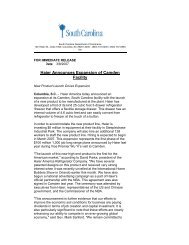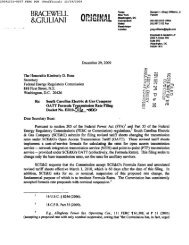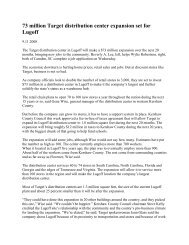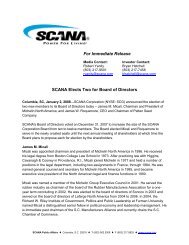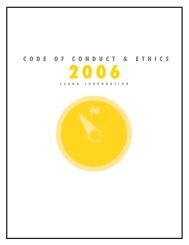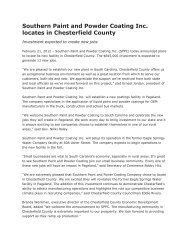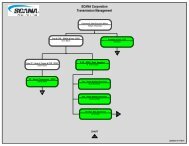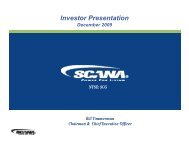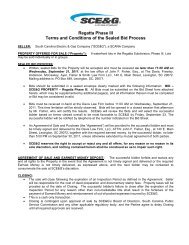10-K - SCANA Corporation
10-K - SCANA Corporation
10-K - SCANA Corporation
Create successful ePaper yourself
Turn your PDF publications into a flip-book with our unique Google optimized e-Paper software.
Table of Contents<br />
$32.7 million, of which SCE&G was responsible for $21.8 million. Total costs for the 2011 outage were $34.1 million, of which<br />
SCE&G was responsible for $22.7 million. In July 2011, SCE&G began accruing $1.2 million per month for its portion of the<br />
refueling planned for the fall of 2012. SCE&G had an accrued balance of $7.2 million at December 31, 2011 and $14.3 million at<br />
December 31, 20<strong>10</strong>.<br />
Nuclear Decommissioning<br />
SCE&G’s two-thirds share of estimated site-specific nuclear decommissioning costs for Summer Station Unit 1, including<br />
the cost of decommissioning plant components both subject to and not subject to radioactive contamination, totals $451.0 million,<br />
stated in 2006 dollars. Santee Cooper is responsible for decommissioning costs related to its one-third ownership interest in Summer<br />
Station Unit 1. The cost estimate assumes that the site would be maintained over a period of approximately 60 years in such a manner<br />
as to allow for subsequent decontamination that would permit release for unrestricted use.<br />
Under SCE&G’s method of funding decommissioning costs, amounts collected through rates ($3.2 million pre-tax in each of<br />
2011, 20<strong>10</strong> and 2009) are invested in insurance policies on the lives of certain SCE&G and affiliate personnel. SCE&G transfers to an<br />
external trust fund the amounts collected through electric rates, insurance proceeds and interest thereon, less expenses. The trusteed<br />
asset balance reflects the net cash surrender value of the insurance policies and cash held by the trust. Management intends for the<br />
fund, including earnings thereon, to provide for all eventual decommissioning expenditures for Summer Station Unit 1 on an after-tax<br />
basis.<br />
Cash and Cash Equivalents<br />
Consolidated SCE&G considers temporary cash investments having original maturities of three months or less at time of<br />
purchase to be cash equivalents. These cash equivalents are generally in the form of commercial paper, certificates of deposit,<br />
repurchase agreements, treasury bills and notes.<br />
Account Receivable<br />
Accounts receivable reflect amounts due from customers arising from the delivery of energy or related services and include<br />
revenues earned pursuant to revenue recognition practices described below. These receivables include both billed and unbilled<br />
amounts. Receivables are generally due within one month of receipt of invoices which are presented on a monthly cycle basis.<br />
Income Taxes<br />
Consolidated SCE&G is included in the consolidated federal income tax return of <strong>SCANA</strong>. Under a joint consolidated<br />
income tax allocation agreement, each <strong>SCANA</strong> subsidiary’s current and deferred tax expense is computed on a stand-alone basis.<br />
Deferred tax assets and liabilities are recorded for the tax effects of all significant temporary differences between the book basis and<br />
tax basis of assets and liabilities at currently enacted tax rates. Deferred tax assets and liabilities are adjusted for changes in such tax<br />
rates through charges or credits to regulatory assets or liabilities if they are expected to be recovered from, or passed through to,<br />
customers; otherwise, they are charged or credited to income tax expense. Also under provisions of the income tax allocation<br />
agreement, certain tax benefits of the parent holding company are distributed in cash to tax paying affiliates, including Consolidated<br />
SCE&G, in the form of capital contributions.<br />
Regulatory Assets and Regulatory Liabilities<br />
Consolidated SCE&G records costs that have been or are expected to be allowed in the ratemaking process in a period<br />
different from the period in which the costs would be charged to expense by a nonregulated enterprise. These regulatory assets and<br />
liabilities represent expenses deferred for future recovery from customers or obligations to be refunded to customers and are primarily<br />
classified in the balance sheet as regulatory assets and regulatory liabilities (See Note 2). The regulatory assets and liabilities are<br />
amortized consistent with the treatment of the related costs in the ratemaking process.<br />
Debt Premium, Discount and Expense, Unamortized Loss on Reacquired Debt<br />
Consolidated SCE&G records long-term debt premium and discount within long-term debt and amortizes them as<br />
components of interest charges over the terms of the respective debt issues. Other issuance expense and gains or losses on reacquired<br />
debt that is refinanced are recorded in other deferred debits or credits and are amortized over the term of the replacement debt, also as<br />
interest charges.<br />
117



